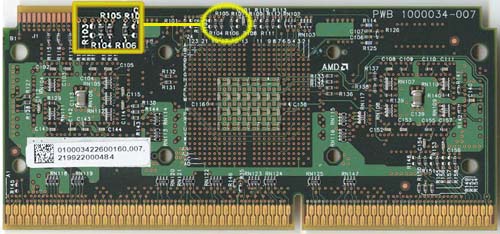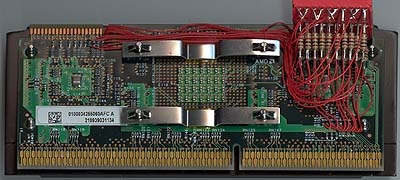AMD Athlon Buyer's Guide - Part 2: Overclocking
by Anand Lal Shimpi on November 9, 1999 8:48 PM EST- Posted in
- Guides
The yields on the Athlon have been incredible; they are high enough that some users are reporting that their lower clock speed Athlon CPUs feature L2 cache chips that would be normally found on the higher speed CPUs. One such case was that of our Athlon 500 evaluation unit from Trinity Micro which featured 3.6ns L2 cache, normally reserved for 600MHz Athlon CPUs.
With the L2 cache capable of hitting the 300MHz required at a 600MHz clock speed, it came to no surprise that our Athlon 500 evaluation unit made it up to 600MHz without even the slightest hiccup. By increasing the core voltage to 1.75v we were able to get the Athlon to POST at 800MHz. Keep in mind that this is from a 500MHz CPU and we disabled the L2 cache in order to test the core itself.
Unfortunately, the problem with this method is that disabling the L2 cache significantly decreases performance in most applications and the raw clock speed increase then only serves as a benefit if you're running a 3D game or another similar application that is not L2 cache dependent. Luckily, there is a way to adjust the L2 cache divider by a method similar to the one used to adjust the clock multipliers and it allows you to change the L2 cache divider from the default /2 (1/2 * clock speed) to /3 or even /1 for a 1:1 L2 cache to core clock speed ratio.
While the latter option isn't really feasible since we would need at least 2ns L2 cache in order to even hit the 500MHz requirement of an Athlon 500 with a 1/1 L2 cache divider, the 1/3 multiplier makes quite a bit of sense. If your L2 cache is the limiting factor with the overclocking potential of your CPU (this can be determined by turning off the L2 cache, and seeing how far your CPU will overclock, then turning it back on and seeing how far it will go then) it may be worth it to settle for the slower 1/3 speed L2 cache but at the higher core clock speed.
So how do you control the L2 cache divider on the Athlon? We already know all of the other settings for clock multiplier and voltage from Tom's Article and below are the settings for the various L2 cache frequency dividers:
Using R103, R104, R106 and R107 located on the back of the Athlon card, the settings are as follows:
L2 Cache Ratio |
R103 | R104 | R106 | R107 |
| 1/1 | OFF | ON | OFF | ON |
| 1/2 | OFF | ON | ON | OFF |
| 1/3 | ON | OFF | OFF | ON |
| 1/5 (Off) | ON | OFF | ON | OFF |

What are the tradeoffs of the lower L2 cache clock speed versus the higher core clock speed? That's what we're here to find out, but first let's take a look at the options offered to us by Trinity Micro's modified Athlon.













0 Comments
View All Comments